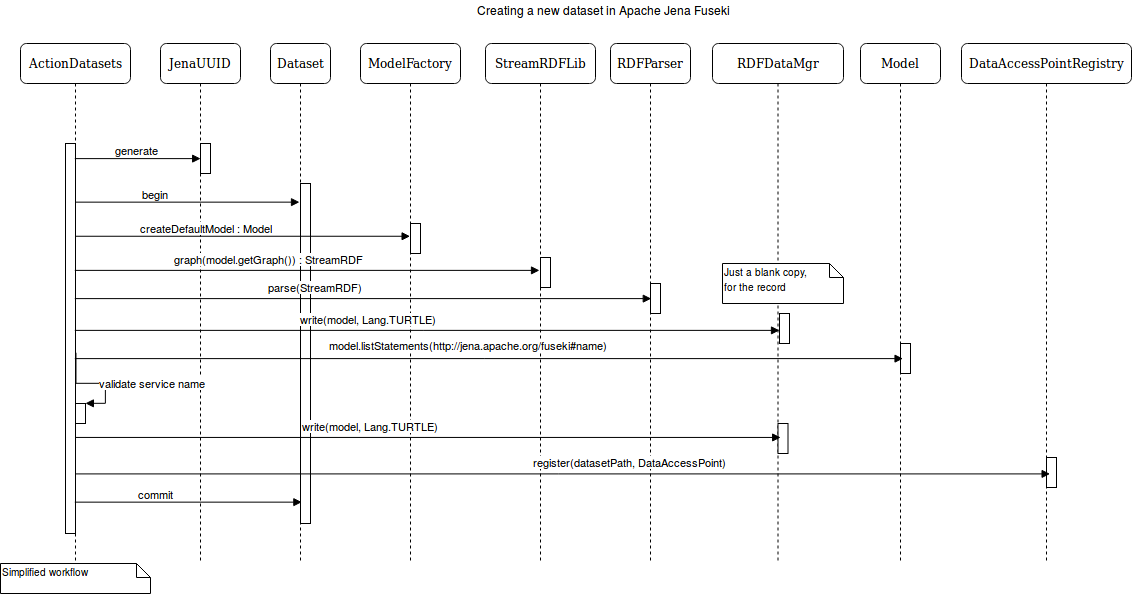What happens when you create a new dataset in Apache Jena Fuseki
Last post was about what happens when you upload a Turtle file to Apache Jena Fuseki. And now today’s post will be about what happens when you create a new dataset in Apache Jena Fuseki.
In theory, that happens before you upload a Turtle file, but this post series won’t follow a logical order. It will be more based on what I find interesting.
Oh, the dataset created is an in-memory dataset. Here’s a simplified sequence diagram. Again, these articles are more brain-dumps, used by myself for later reference.

ActionDatasets#execPostContainer() (Fuseki Core)
ActionDatasets, as per the name, handles HTTP requests related to datasets. Such as when you
create a new dataset. It is also an HTTP action. The concept in Jena, as far as I could tell,
is similar to Jenkins’ actions, but simpler, without the UI/Jelly/Groovy part.
This class also has a few static fields, which hold system information. One variable is actually
called system. (wonder how well it works if you try to deploy Jena Fuseki with multiple JVM’s
1 2).
Its first task is to create an UUID, using JenaUUID (from Jena Core). This class looks
very interesting, [wonder how it works]({% post_url 2018-08-11-uuids-in-apache-jena %}).
Then it creates a DatasetDescriptionRegistry, which is a registry to keep track
of the datasets created. There is also some validation of parameters and state check, and then
the transaction is started (system.begin()).
Model / (Core)
I used Model and ModelFactory before when working with ontologies and Protégé.
ActionDatasets will create a Model.
An RDF Model.An RDF model is a set of Statements. Methods are provided for creating resources, properties and literals and the Statements which link them, for adding statements to and removing them from a model, for querying a model and set operations for combining models.
It also gets a StreamRDF from the model (i.e. model.getGraph()), which will be used
later by the RDFParser.
ActionDatasets#assemblerFromForm() (Fuseki)
In #assemblerFromForm(), it will create a template, and then use
RDFParser to parse the template and load into SteamRFF. The template looks like this:
# Licensed under the terms of http://www.apache.org/licenses/LICENSE-2.0
@prefix : <#> .
@prefix fuseki: <http://jena.apache.org/fuseki#> .
@prefix rdf: <http://www.w3.org/1999/02/22-rdf-syntax-ns#> .
@prefix rdfs: <http://www.w3.org/2000/01/rdf-schema#> .
@prefix tdb: <http://jena.hpl.hp.com/2008/tdb#> .
@prefix ja: <http://jena.hpl.hp.com/2005/11/Assembler#> .
## ---------------------------------------------------------------
## Updatable in-memory dataset.
<#service1> rdf:type fuseki:Service ;
# URI of the dataset -- http://host:port/aaa
fuseki:name "aaa" ;
fuseki:serviceQuery "sparql" ;
fuseki:serviceQuery "query" ;
fuseki:serviceUpdate "update" ;
fuseki:serviceUpload "upload" ;
fuseki:serviceReadWriteGraphStore "data" ;
fuseki:serviceReadGraphStore "get" ;
fuseki:dataset <#dataset> ;
.
# Transactional, in-memory dataset. Initially empty.
<#dataset> rdf:type ja:DatasetTxnMem .
Persisting the dataset
Jena Fuseki will create a local copy of the template, using RIOT’s RDFDataMgr. For my environment, running from
Eclipse, the file location was /home/kinow/Development/java/jena/jena/jena-fuseki2/jena-fuseki-core/run/system_files/902154aa-2bb6-11b2-8053-024232e7b374.
Fuseki now will look for exactly one Service Name statement (http://jena.apache.org/fuseki#name). The name will be validated for things like blank space, empty, ‘/’, etc.
Once the validation passes, then it will persist the file in somewhere like /home/kinow/Development/java/jena/jena/jena-fuseki2/jena-fuseki-core/run/configuration/aaa.ttl. But not without checking first it the file existed.
As this is a brand new file, the Model instance will be written on the file now.
DatasetAccessPoint (ARQ)
Funny, when I wrote it I immediately put this class under Fuseki Core, but it is actually in ARQ. Why not in Fuseki?. Looks like ARQ has a Web layer too.
Fuseki’s FusekiBuilder#buildDataAccessPoint() creates the DataAccessPoint. The DataAccessPoint’s
Javadocs say: “A name in the URL space of the server”.
DataServicecontains operations, and endpoints- Services are added to endpoints, such as an endpoint for the
Quads_RW, theREST_Quads_RWfrom previous post - The name and the data service are used to create the
DataAccessPoint
The current HttpAction in the request contains a reference to Fuseki’s
DataAccessPointRegistry. Fuseki’s DataAccessPointRegistry extends Atlas’
Registry, which uses a ConcurrentHashMap (again, how does it work with multiple JVM’s?).
The new DataAccessPoint is registered with Fuseki’s registry (not the other registry).
And then, finally, the transaction is committed, the response is prepared (a 200 OK in text/plain).
And a null is returned, which means empty response.
And here’s some of the logs produced during this experiment.
[2018-05-28 21:11:43] Config INFO Load configuration: file:///home/kinow/Development/java/jena/jena/jena-fuseki2/jena-fuseki-core/run/configuration/ds2.ttl
[2018-05-28 21:11:43] Config INFO Load configuration: file:///home/kinow/Development/java/jena/jena/jena-fuseki2/jena-fuseki-core/run/configuration/p1.ttl
[2018-05-28 21:11:43] Config INFO Register: /ds2
[2018-05-28 21:11:43] Config INFO Register: /p1
[2018-05-28 21:11:43] Server INFO Started 2018/05/28 21:11:43 NZST on port 3030
[2018-05-28 21:11:52] Admin INFO [1] GET http://localhost:3030/$/server
[2018-05-28 21:11:52] Admin INFO [1] 200 OK (11 ms)
[2018-05-28 21:12:41] Admin INFO [2] GET http://localhost:3030/$/server
[2018-05-28 21:12:41] Admin INFO [2] 200 OK (3 ms)
[2018-05-28 21:22:33] Admin INFO [3] POST http://localhost:3030/$/datasets
[2018-05-28 21:46:25] Admin INFO [3] Create database : name = /aaa
[2018-05-28 22:16:17] Admin INFO [3] 200 OK (3,224.390 s)
[2018-05-28 22:16:18] Admin INFO [4] GET http://localhost:3030/$/server
[2018-05-28 22:16:18] Admin INFO [4] 200 OK (8 ms)
So that’s that.
Happy hacking !
Categories: Blog
Tags: Jena, Apache Software Foundation, Java, Sparql, Opensource